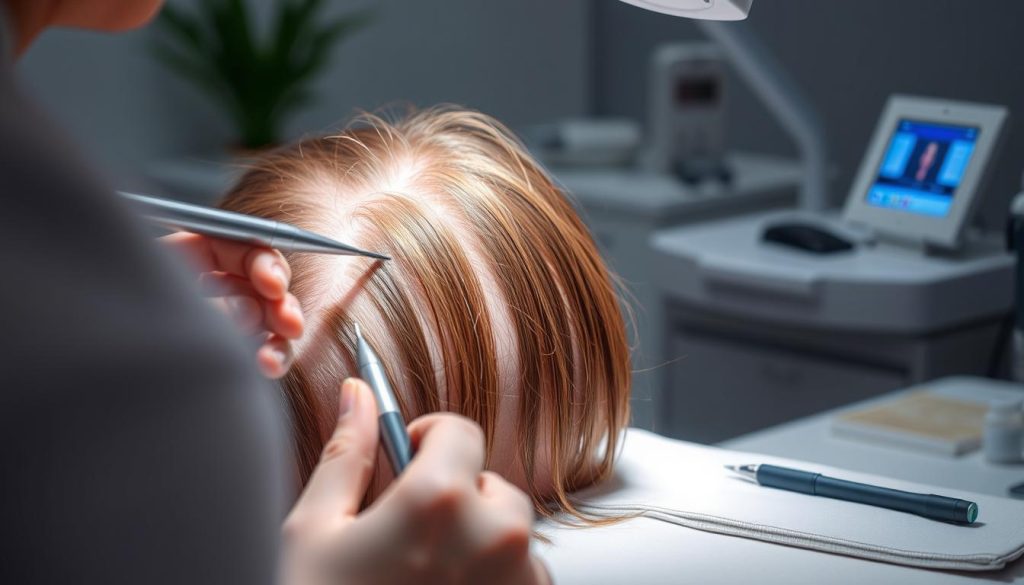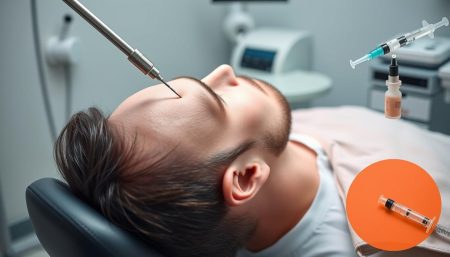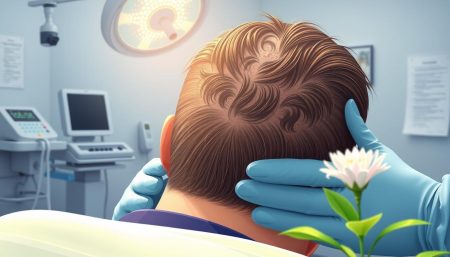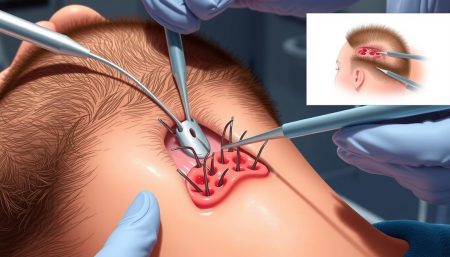Hair loss in women is a big issue affecting millions globally. As more people learn about it, they look for effective treatments. Hair transplants for women are now a top choice, giving hope and confidence to those with thinning hair or bald spots.
Female hair transplantation has made huge strides, leading to natural-looking results. These treatments are designed to match the unique patterns of hair loss in women. They ensure the best results for each person’s needs.
Thanks to new techniques, hair transplants for women are now more common and successful. From traditional methods to advanced robotic systems, the field keeps growing. This offers new chances for those wanting to get back their full, healthy hair.
Understanding Female Pattern Hair Loss and Its Impact
Millions of women worldwide suffer from female pattern hair loss. It causes a lot of distress and affects their self-esteem. This condition, also known as androgenetic alopecia, needs special treatment to manage it well.
Common Causes of Female Hair Loss
Several factors lead to hair loss in women:
- Hormonal changes (pregnancy, menopause)
- Genetic predisposition
- Nutritional deficiencies
- Stress and trauma
- Medical conditions (thyroid disorders, autoimmune diseases)
Psychological Effects of Hair Loss in Women
Hair loss deeply affects women’s mental health, leading to:
- Lowered self-esteem
- Anxiety and depression
- Social withdrawal
- Reduced quality of life
“Losing my hair felt like losing a part of my identity. It’s vital for women to know they’re not alone and that effective treatments exist.” – Sarah, 42
Different Types of Female Alopecia
Knowing the different types of alopecia is key for managing it well:
| Type of Alopecia | Characteristics | Common Treatment Approaches |
|---|---|---|
| Androgenetic Alopecia | Gradual thinning at the part line | Minoxidil, hormone therapy |
| Alopecia Areata | Patchy hair loss | Corticosteroids, immunotherapy |
| Traction Alopecia | Hair loss due to tight hairstyles | Changing hairstyles, minoxidil |
| Telogen Effluvium | Temporary, diffuse hair shedding | Treating underlying causes, nutritional support |

It’s important to know the type and cause of hair loss for a good treatment plan. Early action and a detailed approach to managing alopecia can lessen both physical and emotional effects of hair loss.
Hair Transplant for Women: Modern Solutions and Techniques
Hair transplant for women has seen big changes in recent years. Now, there are special solutions for female hair loss. These new methods give natural-looking results, boosting confidence and energy.

Unlike old methods for men, hair transplants for women target thinning areas. The crown and part line get extra care. Surgeons use new techniques to blend with existing hair, making the change subtle yet striking.
Follicular Unit Extraction (FUE) is a popular method. It’s a gentle way to take hair follicles from donor areas. Then, these follicles are placed in thinning spots. FUE means quicker healing and less scarring, which many women find attractive.
| Technique | Benefits | Recovery Time |
|---|---|---|
| FUE | Minimal scarring, natural-looking results | 1-2 weeks |
| FUT | Larger number of grafts in one session | 2-3 weeks |
| Robotic Hair Transplant | Precision, consistency | 1-2 weeks |
Platelet-rich plasma (PRP) therapy is another big step forward. It’s used with transplantation to boost hair growth. PRP uses the patient’s own blood to help hair follicles grow, leading to thicker, healthier hair.
With ongoing improvements, hair transplant for women is becoming a real solution for hair loss. These modern methods offer custom treatments and natural results. They help women feel confident and enjoy fuller, more vibrant hair.
Evaluating Candidacy for Female Hair Restoration
Figuring out if you’re a good fit for female hair restoration is complex. It involves looking at many factors. This ensures the best results for ladies seeking trichology solutions.
Medical Requirements and Considerations
Getting a health check is essential before starting hair restoration. Doctors look at your overall health, hormone levels, and any medical conditions. Some medicines or treatments might make you not eligible.
Age and Hair Loss Pattern Assessment
Age is key when it comes to hair restoration. Younger women might start with non-surgical methods. Hair loss patterns vary among women, guiding the treatment choice.
Donor Area Availability
The success of hair transplants depends on the quality and amount of donor hair. Women usually have fewer donor areas than men. Experts check scalp laxity and hair density to see if it’s possible.
| Factor | Impact on Candidacy |
|---|---|
| Medical History | Can affect treatment options |
| Age | Influences long-term outcomes |
| Hair Loss Pattern | Determines restoration approach |
| Donor Hair Quality | Critical for transplant success |
Women who don’t fit the bill for surgery might look into other trichology options. These could include medicines, scalp treatments, or non-invasive methods. They aim to boost hair growth and scalp health.
Follicular Unit Transplantation (FUT) for Female Patients
Follicular unit transplantation is a good choice for women with hair loss. It takes hair from the back of the head, where hair grows well.

This method is designed for women’s hair loss patterns. Women often lose hair all over, not just in spots. So, a skilled surgeon must place the grafts carefully for a natural look.
One big plus of FUT for women is that many grafts can be transplanted at once. This is great for those with a lot of hair loss or wanting more hair.
- Suitable for women with moderate to severe hair loss
- Provides natural-looking results
- Allows for transplantation of a large number of grafts
- Minimal disruption to existing hair
Recovery from FUT takes 10-14 days. Most women can go back to work in a week. Remember, the transplanted hair might fall out first. But, new hair starts growing in 3-4 months, and the full effect is seen after 12-18 months.
“FUT has been a game-changer for many of my female patients, restoring their confidence.”
While FUT can give great results, it’s key to talk to a hair restoration expert. They can tell if it’s right for you.
Advanced FUE Techniques in Women’s Hair Restoration
Follicular unit extraction for females has changed hair regrowth for ladies. This new method brings many benefits for women looking to restore their hair.
Benefits of FUE for Female Patients
FUE leaves little to no scarring and looks natural. It lets doctors take out individual hair follicles carefully. This way, the new hair blends well with the rest.
Women can feel more confident without anyone noticing they’ve had treatment.
Recovery Timeline and Expectations
Recovery from FUE is fast. Most people can go back to their usual activities in just a week. At first, they might lose some hair, but new growth starts around three months later.
It takes 12-18 months to see the full effects.
Long-term Results and Maintenance
FUE gives lasting results for hair growth in women. The transplanted hair grows like natural hair and needs regular care. To keep the best results, following a good hair care routine is key.
Supplementary treatments might also help.
“FUE has transformed my life. I never thought I’d feel confident about my hair again, but now I love how I look!”
Women thinking about FUE should talk to a skilled specialist. They can check if this advanced method is right for their hair needs.
Non-Surgical Alternatives to Hair Transplantation
Women looking for non-surgical hair renewal have many choices. These options are great for those not ready for surgery or who want a gentler approach to treating hair loss.
Platelet-rich plasma (PRP) therapy is becoming more popular. It involves taking a patient’s blood, enriching it with growth factors, and then injecting it into the scalp. This treatment boosts hair follicles, leading to new hair growth and thicker existing hair.
Low-level laser therapy (LLLT) is also a good choice for hair loss treatment. It uses red light to wake up hair follicles, improve blood flow, and help hair grow. You can get LLLT in clinics or use devices at home, making it easy for many women.
Topical medications are a key part of non-surgical hair care. Minoxidil, available without a prescription, is FDA-approved for women. It helps slow down hair loss and encourages new hair growth when used regularly.
| Treatment | Advantages | Limitations |
|---|---|---|
| PRP Therapy | Natural, uses patient’s own blood | Multiple sessions required |
| LLLT | Non-invasive, can be done at home | Results may vary, ongoing treatment needed |
| Topical Medications | Easily accessible, FDA-approved | Long-term use necessary for continued results |
These non-surgical options give women different ways to fight hair loss without surgery. Talking to a hair restoration expert can help find the best treatment for your needs and hair loss pattern.
Cost Considerations and Investment in Hair Restoration
Thinking about a hair transplant for women? It’s key to know the money side. The cost of female hair restoration changes based on several things. It’s important to think about the long-term gains.
Price Factors and Variables
The price of a hair transplant for women changes with hair loss, technique, and where you go. More advanced methods like FUE might cost more but can give better results. In the US, here’s what you might pay:
| Procedure Type | Price Range (USD) | Average Cost |
|---|---|---|
| FUT | 3,000 – 15,000 | 7,000 |
| FUE | 5,000 – 20,000 | 10,000 |
| Robotic FUE | 8,000 – 25,000 | 15,000 |
Insurance Coverage Options
Most insurance doesn’t cover hair transplants for women because they’re seen as cosmetic. But, some plans might cover it if it’s for medical reasons or trauma. Always check with your insurance to see what they cover.
Financing Solutions
Many clinics help with financing to make hair restoration more affordable. They offer:
- Payment plans with low or no interest
- Medical credit cards
- Personal loans
- Healthcare-specific financing companies
Even though it might seem expensive at first, many women find it’s worth it. The confidence boost and better life quality make it a good investment.
Post-Procedure Care and Recovery Guidelines
After a women’s hair loss treatment, it’s important to care for your hair well. The steps for hair regrowth for ladies include several key actions. These help your hair heal and grow back successfully.
Don’t touch or wash the treated area for at least 24 hours after the procedure. Start gentle cleansing with a mild shampoo after this time. Your surgeon will recommend the best shampoo for you.
For the first few nights, sleep with your head raised to reduce swelling. Stay away from hard work and direct sunlight for two weeks after the treatment.
- Take prescribed medications as directed
- Attend all follow-up appointments
- Refrain from using hair styling products for 2-3 weeks
- Avoid alcohol and smoking during the initial recovery phase
It’s normal to see some shedding of transplanted hair in the first weeks. This is part of the natural growth cycle. It shouldn’t worry you. New hair growth usually starts in 3-4 months.
“Patience is key in the hair restoration journey. Consistent care and following your surgeon’s guidelines will lead to the best possible outcome.”
For long-term care, eat well, take good care of your hair, and might use hair growth products. Regular check-ups with your specialist are important. They help track your progress and solve any issues during the hair regrowth journey for ladies.
Latest Innovations in Female Hair Transplant Technology
The field of hair transplant for women is changing fast. New technologies are making hair restoration treatments better. These changes bring hope to those looking for effective hair growth solutions.
Robotic Hair Transplant Systems
Robotic systems have changed hair transplantation. These precise devices help surgeons place hair follicles accurately. For women, this means less scarring and better graft placement.
The ARTAS iX system is a top robotic platform. It offers many benefits for female patients:
- Reduced procedure time
- Minimal discomfort
- Faster recovery
- Natural-looking results
Stem Cell Research Applications
Stem cell therapy is a new hope in hair restoration. Scientists are working to use stem cells to grow new hair follicles. This could be a long-term fix for female pattern baldness.
| Stem Cell Approach | Potential Benefits |
|---|---|
| Follicular Stem Cell Activation | Stimulates dormant hair follicles |
| Adipose-Derived Stem Cells | Promotes hair growth and thickness |
| Stem Cell-Enriched Hair Transplants | Enhances graft survival rates |
New technologies are changing hair transplants for women. They offer hope and effective solutions for hair loss. As research continues, we’ll see even more innovative treatments. These will improve outcomes for female patients.
Combining Hair Transplants with Other Treatments
Female hair restoration often needs a mix of treatments. Using hair transplants with other methods can make results better. This way, women get a strong plan to fight hair loss.
Platelet-Rich Plasma (PRP) therapy is a favourite add-on. It uses the patient’s own platelets to boost hair growth. When paired with hair transplants, PRP helps grafts survive and heal faster.
Low-Level Laser Therapy (LLLT) is another good match for hair surgery. It uses red light to wake up hair follicles. This can make hair transplants work better.
Topical medicines like minoxidil are also key. They keep hair growing and help new hair after a transplant. Using them regularly is important.
| Treatment | Benefits | Frequency |
|---|---|---|
| PRP Therapy | Improves graft survival, stimulates growth | Every 4-6 weeks initially |
| LLLT | Enhances cellular activity in follicles | 2-3 times per week |
| Topical Minoxidil | Maintains existing hair, supports new growth | Daily application |
By mixing these treatments with hair transplants, women can get better and lasting results. They can enjoy fuller, healthier hair.
Choosing the Right Hair Transplant Specialist
Finding the right specialist for a hair transplant is key for success. The surgeon you choose can greatly affect your results.
Qualifications to Look For
When looking for a hair transplant specialist, focus on these qualifications:
- Board certification in dermatology or plastic surgery
- Extensive experience in female hair restoration
- Membership in professional organisations like the International Society of Hair Restoration Surgery
- Before and after photos of previous female patients
- Positive patient reviews and testimonials
Questions to Ask During Consultation
At your consultation, ask these important questions:
- How many female hair transplant procedures have you performed?
- What technique do you recommend for my specific case?
- Can you show me examples of your work on patients with similar hair loss?
- What results can I realistically expect?
- What is the total cost of the procedure, including follow-up care?
By carefully checking specialists and asking the right questions, you can get the best care for your hair transplant.
Long-term Results and Success Rates
Female hair restoration offers promising long-term results for women seeking hair regrowth. The success rates of these procedures have improved a lot. Many patients see good results.
Hair regrowth for ladies follows a timeline. Patients see initial results in 3-4 months. After 6-12 months, they see big improvements. Full results appear 12-18 months after the procedure.
Several factors affect the success of female hair restoration:
- Patient’s overall health
- Compliance with post-operative care instructions
- Ongoing hair loss management
- Quality of the donor hair
- Skill of the surgeon
To keep results good, some patients need follow-up treatments. It’s key to have realistic hopes. Remember, results can vary.
| Time Frame | Expected Results |
|---|---|
| 3-4 months | Initial growth visible |
| 6-12 months | Significant improvement |
| 12-18 months | Full results apparent |
Studies show women who get hair transplants are very happy. They feel better about themselves and their lives. Success comes from choosing a skilled specialist and caring for your hair well after the procedure.
Managing Expectations and Timeline for Results
When thinking about a hair transplant for women, knowing the timeline for results is key. The outcomes of women’s hair loss treatments can differ. Being patient is essential during this time.
Initial Growth Phase
The first phase after a hair transplant for women might seem tough. The transplanted hair often falls out in the first few weeks. This is normal and doesn’t mean it’s failed.
New hair growth starts around the third month. At this time, you’ll see fine, wispy hairs coming from the transplanted follicles.
Final Results Timeline
The path to full results takes time. Most women see big improvements between 6 to 9 months after the procedure. The final results usually show up after 12 to 18 months.
During this time, the hair will keep getting thicker and blending with your natural hair.
| Timeline | Expected Progress |
|---|---|
| 1-2 weeks | Initial shedding of transplanted hair |
| 3-4 months | New hair growth begins |
| 6-9 months | Noticeable improvement in hair density |
| 12-18 months | Final results visible |
It’s vital to keep your expectations realistic and follow the care instructions after the procedure. Regular visits to your specialist can help track your progress. They can also address any worries you have during your hair loss treatment journey.
Prevention Strategies and Maintenance After Treatment
After a hair transplant, women must care for their new hair. Eating well and exercising helps keep the scalp healthy. Stress can cause hair loss, so finding ways to relax is important.
Using gentle hair care is essential. Avoid harsh chemicals and heat styling tools. Use a soft brush and mild shampoo to clean without stripping natural oils. Wearing hats or scarves outdoors protects hair from the sun.
Regular check-ups with a hair specialist are vital. They can spot early signs of thinning and suggest treatments. Some women might need extra care like scalp treatments or special products. These visits ensure the hair transplant’s long-term success.
Hair health is a journey. Consistent care and smart lifestyle choices support lasting results. By following these tips, women can enjoy their restored hair for years to come.
FAQ
Q: What are the most common causes of hair loss in women?
A: Hair loss in women can be caused by genetics, hormonal changes, and medical conditions. Nutritional deficiencies, stress, and certain medications also play a role. It’s wise to see a trichologist or dermatologist to find out why you’re losing hair.
Q: Are hair transplants suitable for all types of female hair loss?
A: Hair transplants work best for pattern hair loss or traction alopecia. They’re not for everyone, like those with diffuse hair loss or autoimmune diseases. A hair restoration specialist will check if you’re a good candidate.
Q: How long does it take to see results after a hair transplant?
A: Results from a hair transplant start to show around 3-4 months after. You’ll see big improvements by 6-9 months. Full results take 12-18 months. Be patient during this time.
Q: What is the difference between FUT and FUE techniques for women?
A: FUT takes a strip of scalp and breaks it into units. FUE takes units directly from the scalp. FUE is often chosen for women because it has less scarring and quicker recovery. Your surgeon will decide the best method for you.
Q: How much does a hair transplant for women typically cost?
A: Hair transplant costs vary a lot. It depends on how much hair you need, the technique, the surgeon’s skill, and where you are. In the UK, prices range from £3,000 to £15,000 or more. Get quotes from several clinics.
Q: Are there any non-surgical alternatives to hair transplants for women?
A: Yes, there are non-surgical options. These include PRP therapy, low-level laser therapy, and topical or oral medications. Hair growth supplements are also available. These treatments can be used alone or together for better results.
Q: How long is the recovery period after a female hair transplant?
A: Recovery time varies by technique. You can usually go back to light activities in a few days. The area might be sensitive for 1-2 weeks. FUE takes 10-14 days to heal, while FUT takes 2-3 weeks. Always follow your surgeon’s instructions.
Q: Can hair transplants be combined with other hair loss treatments?
A: Yes, hair transplants can be paired with other treatments. Many surgeons suggest PRP, low-level laser therapy, or topical medications to improve transplant results. This combination can lead to better and longer-lasting results.
Q: What qualifications should I look for in a hair transplant specialist?
A: Look for a specialist with board certification in dermatology or plastic surgery. They should have experience in hair restoration for women. Membership in organisations like the International Society of Hair Restoration Surgery (ISHRS) shows they’re experts.
Q: Are there any age restrictions for women seeking hair transplants?
A: There’s no strict age limit, but most surgeons prefer patients over 25. Age isn’t as important as the stability of hair loss. Younger women might be advised to wait if their hair loss is changing. Older women can be great candidates if they have enough donor hair and are healthy.


















